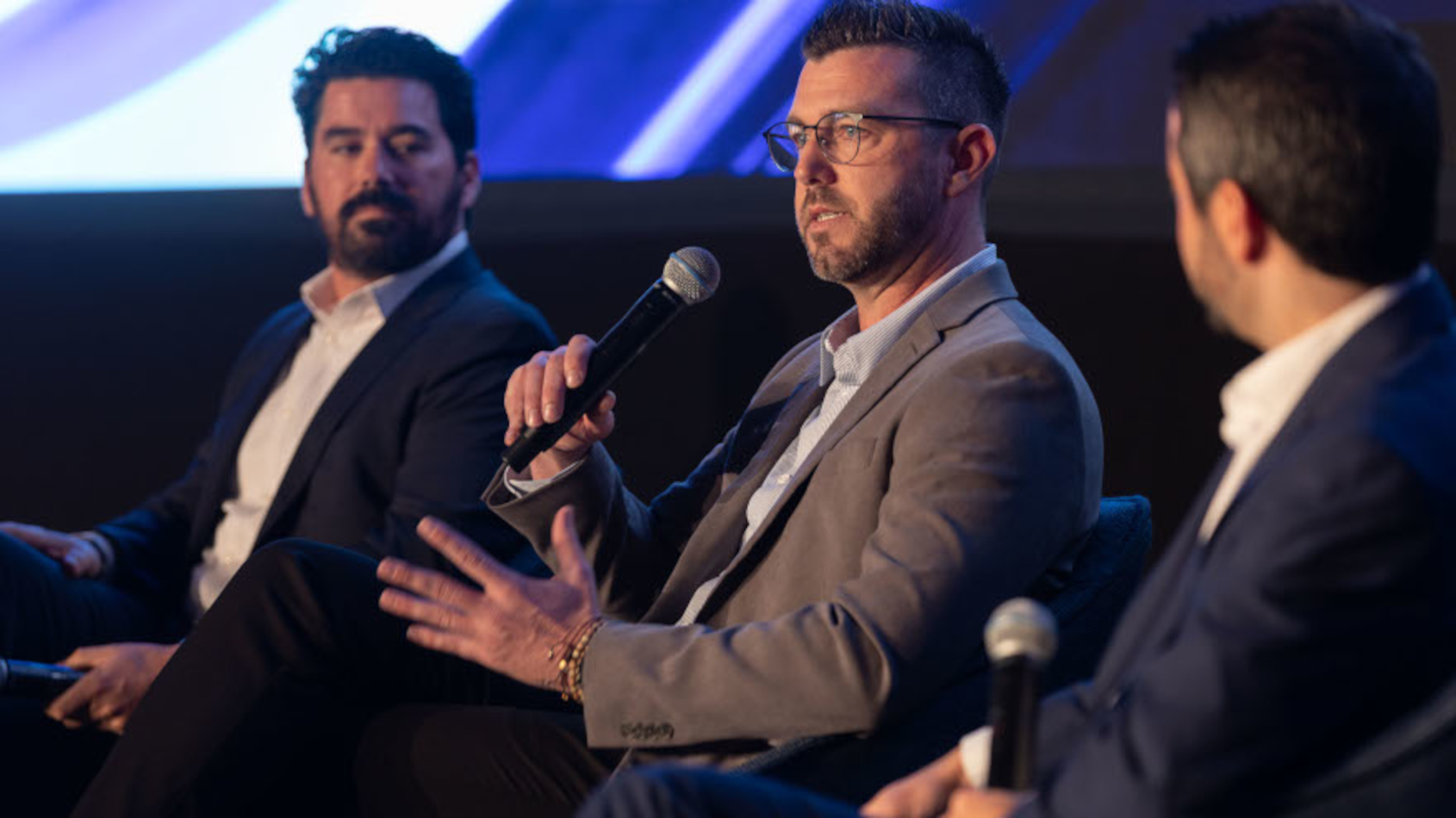COMMENTARY: Smart inventory management will play critical role in next phase of automotive retail

Jon Karasek of Mach10 Automotive answers a question during Used Car Week 2024 in Scottsdale, Ariz. Photo by Jonathan Fredin.
With the U.S. government’s stance on tariffs resembling a game of seesaw, yet with the net effect likely to push vehicle prices higher, automotive dealers who already understand the importance of mastering both inventory management and customer portfolio strategy will be a step ahead. The market is shifting fast, and those who can pivot quickly will protect their profitability while others will scramble to catch up.
New-vehicle prices are poised for an increase. There is consensus that a tariffs hike will lead to a growing consumer interest in used vehicles, especially newer models that offer value without the premium price tag. Dealers who can master the full, used inventory lifecycle, from smart trade-in valuation to faster reconditioning and dynamic pricing, will be able to capitalize and protect their margins.
Concurrently, floor plan management will become more critical than ever. As inventory replacement costs rise, dealers who manage financing costs tightly, move aging inventory quickly, and balance stock intelligently will avoid the profit erosion others will face.
As we’re heading into a tariff-driven market, lessons learned during Covid-19 will be important to navigate through the post COVID-era trade cycle that is already underway.
Thousands of consumers who leased vehicles during the pandemic, when supply was tight, and prices were already inflated, have stepped into new cars over the past 12-18 months. Those customers fared OK, compared to what they paid three to four years ago.
Leasing takes center stage
Consumers who financed vehicles on five- or six-year loans and those with older trade-ins, who sat on the sidelines waiting for prices to “normalize”, are about to experience real sticker shock. For this group, leasing becomes not just an option, but one of the few accessible pathways to getting into a new vehicle without bearing the full weight of inflation and tariffs on their monthly budget.
In this climate, the ability to position leasing effectively, through payment-focused marketing, flexible mileage options, and aggressive OEM programs, will be a defining skill. Combined with sharp used car acquisition, fast reconditioning, and disciplined floor plan management, dealers can present lease customers with strong trade-in values and compelling upgrade offers that feel like a win.
In short, leasing won’t just be a tool, it will be the key to a winning customer management strategy that keeps deal flow alive and loyal customers from walking away. Pragmatically, executing more deals through leases “softens” the sticker shock for the consumer as well as enables a dealer to lease the customer a new vehicle in 36 months because of the shorter “ownership” cycle through a finance deal. My math tells me you can lease a customer 2 vehicles compared to 1 finance deal in 72 months.
Lessons from COVID-19 can be applied to managing inventory
Dealers will find their previously learned inventory management strategies even more valuable with the impending tariff increase, as it will significantly impact vehicle costs and demand.
Here are some of the lessons COVID-19 taught us, and some of the strategic initiatives that can prove to be particularly helpful:
Prioritizing used inventory:
As new vehicle prices increase due to tariffs, dealers may see a shift in consumer interest towards used vehicles even though used-car prices will go up in value in sync with higher new-car prices. Mastering inventory management for used vehicles, including trade-in valuation and managing trade-in inventory effectively, will be key.
- Source aggressively: Trade-ins, service lane purchases, lease returns, and local buying will be critical. Auction prices will rise — avoid overpaying.
- Shorten reconditioning time: Get used cars retail-ready faster to turn inventory quickly.
- Price dynamically: Use market data to update pricing frequently based on regional demand, not static gross targets.
- Expand certified pre-owned (CPO): Offer CPO options to meet demand for quality at a lower price point.
Optimizing floor plan management:
Dealers will need to be mindful of how they finance their inventory, especially with the potential for higher replacement costs for new vehicles. Efficient floor plan management, including analyzing loan rates and managing floor plan costs, will be essential.
- Age inventory precisely: Target 45-day (or less) turn goals, with clear exit strategies for aged units (discounts, wholesaling, etc.).
- Reforecast carrying costs: With higher MSRP and vehicle prices, interest and holding costs will have an outsized impact on profit margins.
- Align finance terms: Work with lenders to optimize curtailment schedules and flexibility.
Adapting to market shifts:
Dealers should anticipate changes in consumer behavior and demand, as we have already experienced sales increases in anticipation of higher prices. Strong inventory management will allow them to adapt their sales strategies and manage their supply chain more effectively.
- Stay ahead of shifts: Watch for early signals such as decreased showroom traffic, decreased website visitor counts, decreased click-through inquiry counts, or changes in credit trends and adjust stocking plans monthly.
Focusing on fixed operations:
With potential price hikes on parts due to tariffs, fixed operations (service and repairs) will become even more important. Dealers can use their existing knowledge of inventory management to optimize their fixed operations and potentially offer extended warranties or prepaid maintenance plans to mitigate potential price increases.
- Push service contracts: Prepaid maintenance and extended warranties protect buyers against rising parts costs.
- Use service lanes for sourcing: Train service writers to identify prime trade-in candidates for every visit.
Increased focus on inventory management:
Inventory management is one of the most critical aspects of a dealer’s business operation, and the expected tariff will test even the best operators’ ability to maximize both new and used car inventories. Those who prepare for the next phase by outlining and following specific inventory management strategies will come out on top.
- Order strategically: Prioritize fast-moving models, trims, and specifications that align with current buyer demand.
- Avoid overstocking: Higher costs mean higher carrying risks. Limit slow movers to protect floor plan costs.
- Negotiate early: Work closely with OEMs to lock in allocations and pricing wherever possible before tariffs are fully reflected.
- Promote affordability: Structure marketing around total cost of ownership, fuel economy, service plans, and payment flexibility.
- Educate the customer: Especially for used car buyers shocked by pricing, show value through quality, warranty options, and certified programs.
Dealers who actively manage sourcing, floor plan exposure, and marketing messaging – while staying laser-focused on inventory age and consumer sentiment – will be far better prepared for the financial pressures the new tariffs will create.
By implementing these strategies, businesses can optimize their inventory management processes, reduce costs, improve customer satisfaction, and gain a competitive advantage. In short, the next 12–24 months will separate dealers who operate with precision from those who rely on old habits. Tight inventory management, smarter forecasting, and leveraging the benefits leasing offers both the consumer and the dealer will be key to navigating through the complexity and impact tariffs are expected to have.
Ready or not, the market’s changing. The right moves now will define who leads, and who falls behind.
Having recently held the position of regional director of digital strategy and innovation for the industry’s largest independent auto auction group, Jon’s skills range from mechanical/technical certifications to wholesale and retail sales. Jon was recognized for leadership accomplishments when honored with the 2021 Auto Remarketing 40 Under 40 Award. He is an accomplished auctioneer with over 20 years of experience in the automotive industry, having served as the GM of one of Southern California’s premier wholesale auto auctions. Today, Jon holds the position as vice president, innovation at Mach10 Automotive, an automotive M&A firm offering a full suite of dealer performance optimization services.


